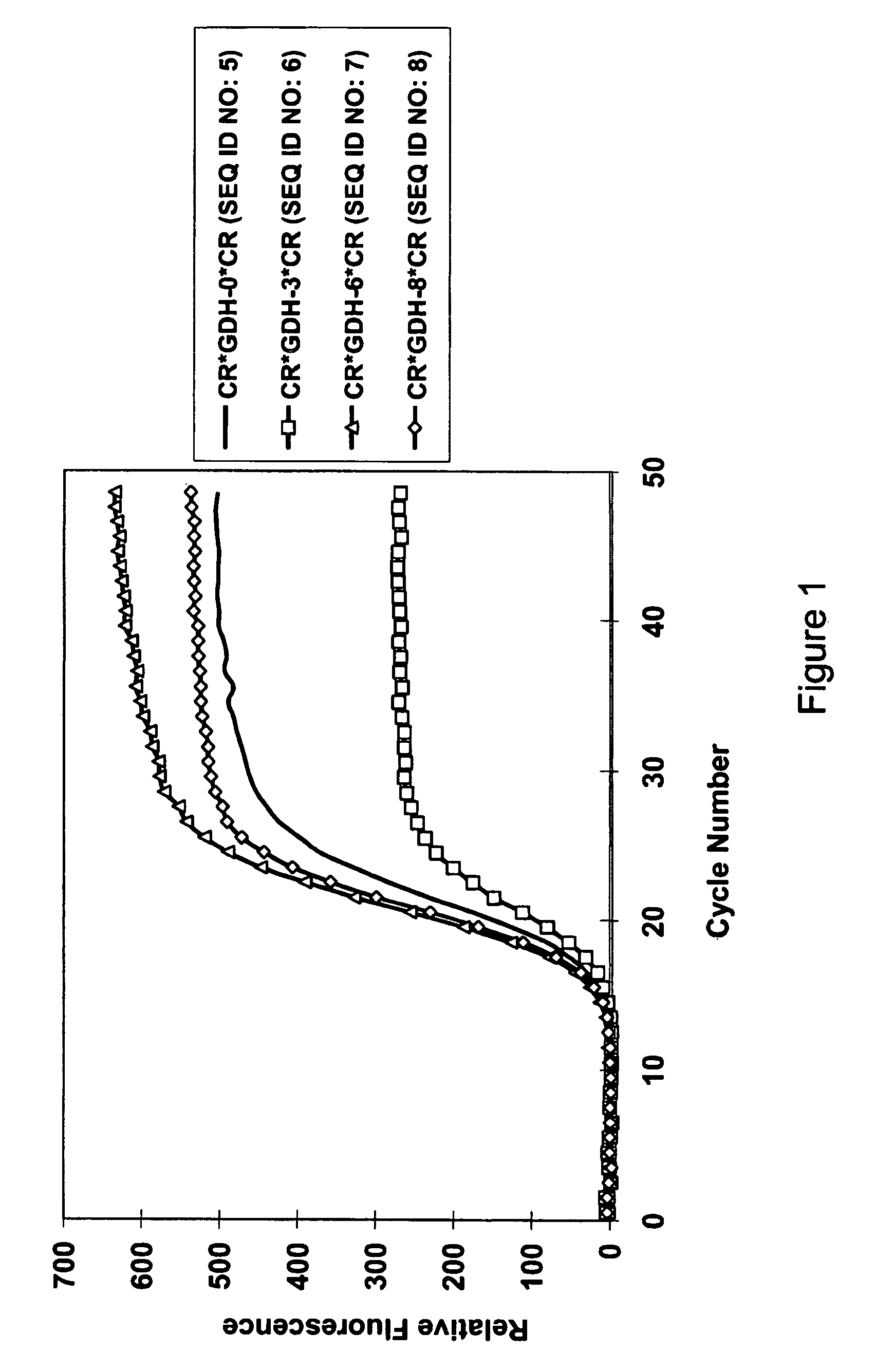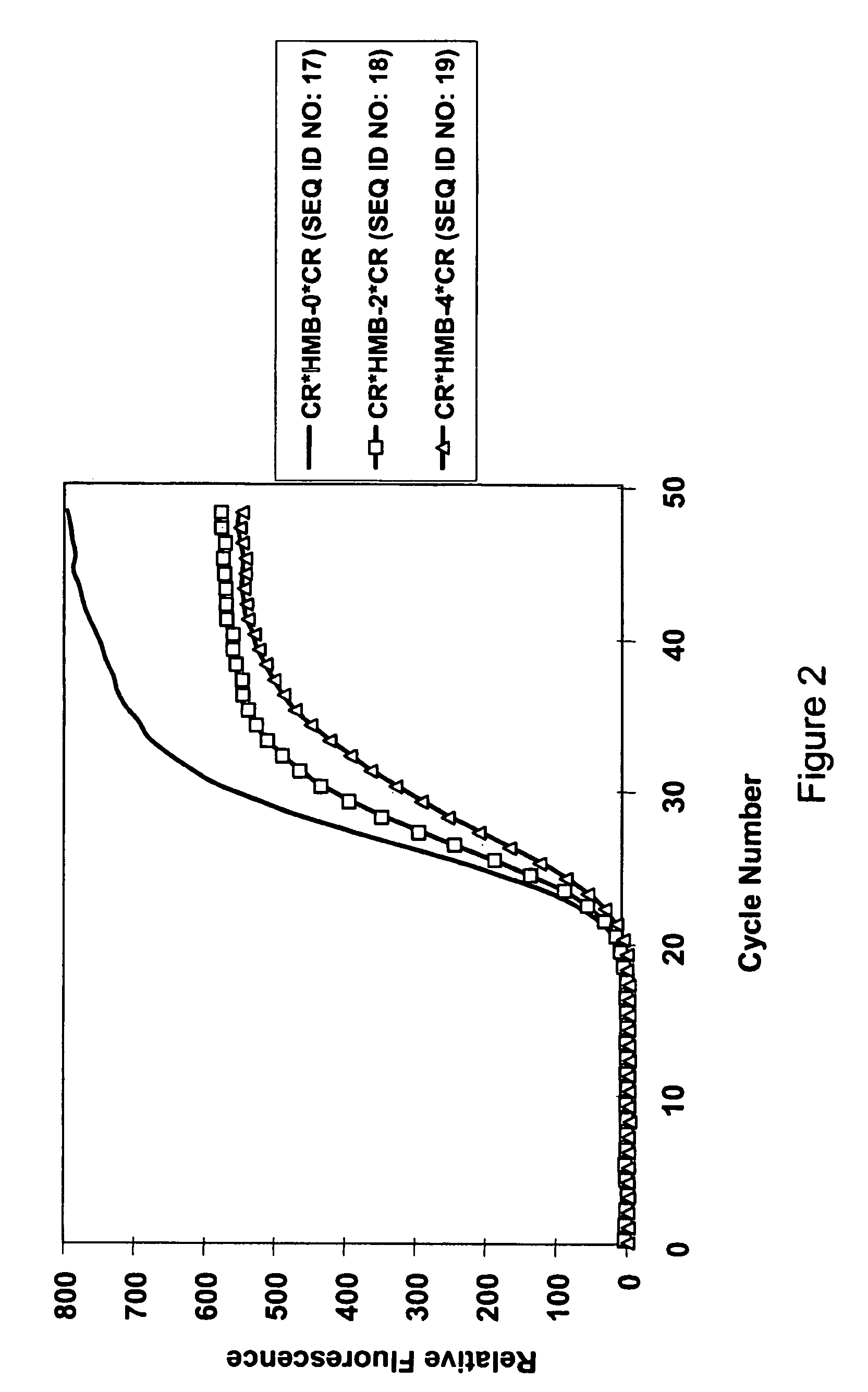Oligonucleotide probes and uses thereof
a technology of oligonucleotide probes and probes, applied in the field of oligonucleotide probes, can solve the problems of inability to achieve the effect of enhancing the hybridization of probes, increasing fluorescence due to less efficient frets, and high cost and time-consuming taqman® probes
- Summary
- Abstract
- Description
- Claims
- Application Information
AI Technical Summary
Benefits of technology
Problems solved by technology
Method used
Image
Examples
example 1
[0163]Oligonucleotide Synthesis and Labeling
[0164]Materials and Equipment: All anhydrous solvents and phosphoramidite reagents including phosphoramidites of nucleosides and protected linkers were purchased from Proligo, Boulder, Colo. or Glen Research, Sterling, Va. All unlabeled and amine-modified oligonucleotides were synthesized on an Expedite 8909 oligonucleotide synthesizer by Applied Biosystems (Foster City, Calif.).
[0165]Primer and Probe design: Primer sequences were selected using the commercial software Primer Express from Applied Biosystems (Foster City, Calif.) or the public web-based software Primer3 (http: / / frodo.wi.mit.edu / cgi-bin / primer3 / primer3_www.cgi). Detailed sequence information along with the computer-predicted melting temperatures for the primer sequences are listed in Table 1. Probe sequences having conventional melting temperatures were also selected using the same softwares. The conventional probe sequences were then systematically truncated by 2 to 10 nucl...
example 2
[0183]Real Time PCR:
[0184]All nucleic acid amplifications were performed in 20 μL reaction solution containing 10 mM Tris (pH 8.0), 50 mM KCl, 2.5 mM MgCl2, 2 mM each of dNTP, and 1 unit of AmpliTaq Gold from ABI (Foster City, Calif.). Each template used in the amplification experiments was a gene fragment cloned in pTOPO plasmid (Invitrogen, Calsband, Calif.). All reactions were run with 107 copies of plasmid template and 0.5 μM each of a forward primer, a reverse primer, and a doubly labeled probe. For all reactions the thermal regimen was set at 95° C. for 10-minutes followed by 50 cycles of 15-second duration at 95° C. and 60-second duration at 60° C. Similarly, for all reactions fluorescence was measured at the 60° C. step with filter set of 490 nm / 525 nm for 5-CR110 or FAM, 535 nm / 575 nm for 5-R6G in BioRad IQ cycler.
[0185]Performance of varying length of GDH probes that are labeled with homo-dual 5-carboxy-rhodamine 110 dyes: CR*GDH-0*CR (SEQ ID No.5) was designed by PrimerEx...
PUM
| Property | Measurement | Unit |
|---|---|---|
| Tm | aaaaa | aaaaa |
| Tm | aaaaa | aaaaa |
| Tm | aaaaa | aaaaa |
Abstract
Description
Claims
Application Information
 Login to View More
Login to View More - R&D
- Intellectual Property
- Life Sciences
- Materials
- Tech Scout
- Unparalleled Data Quality
- Higher Quality Content
- 60% Fewer Hallucinations
Browse by: Latest US Patents, China's latest patents, Technical Efficacy Thesaurus, Application Domain, Technology Topic, Popular Technical Reports.
© 2025 PatSnap. All rights reserved.Legal|Privacy policy|Modern Slavery Act Transparency Statement|Sitemap|About US| Contact US: help@patsnap.com



